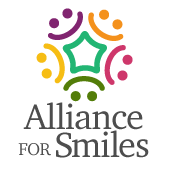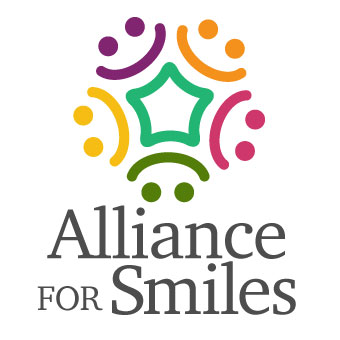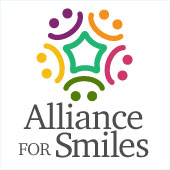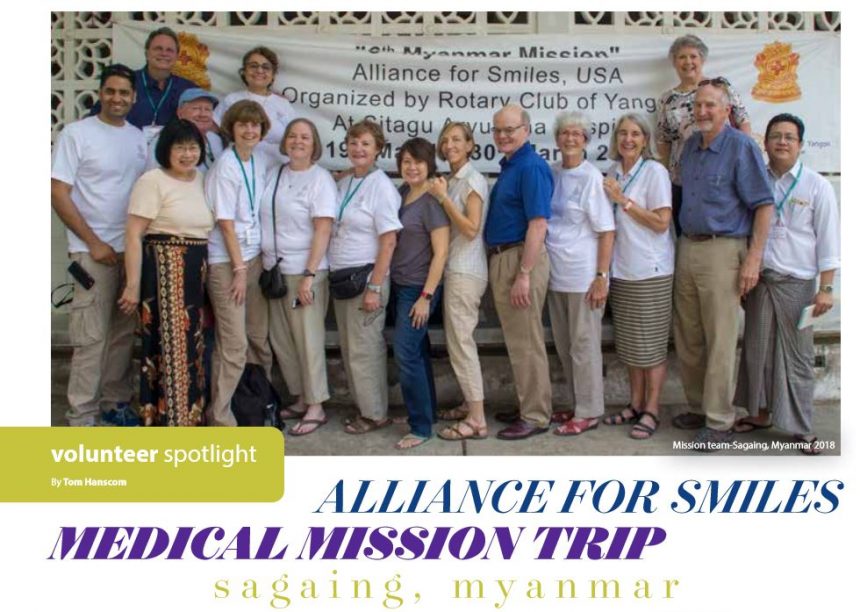Volunteer Photographer Tom Hanscom
Tom wrote this touching article for his community newspaper when he returned from his mission to Sagaing, Myanmar
What do you say to Tina Fischlin when she approaches you at Rotary Club meeting and asks you to be the photographer on the next Alliance for Smiles (AFS) medical mission trip to Sagaing, Myanmar? My initial gut reaction was to say “no,” of course, but instead, I said, “maybe” and “let me think about it.” I went home and told my wife about what happened at the meeting, and she said that she thought it would be a wonderful experience, giving me what I thought was her approval.
Tina approached me again a few weeks later, saying she would put me down but that I could always change my mind when it got closer to time, seemingly giving me a way out. How hard could this be? Both of my daughters have been on medical mission trips to Africa, and they lived to tell about it.
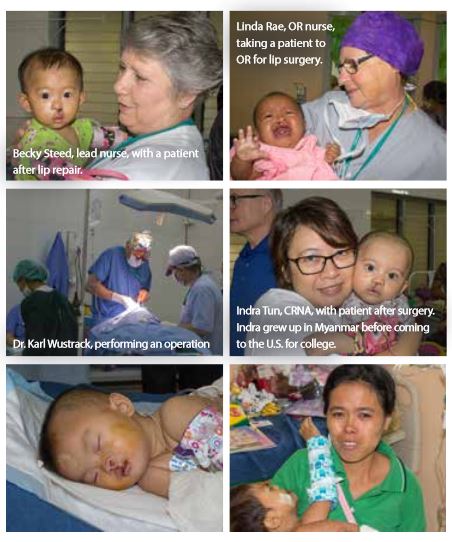 The first questions that came to mind were “Where in the world is Sagaing, Myanmar?” and “What have I gotten myself into?” I also had to research exactly what AFS did to help transform people’s lives. After several Google searches, I was able to determine that Myanmar used to be called Burma and is in the middle of Asia; at least, I had heard of Burma. Alliance for Smiles offers children and families with cleft anomalies hope for a brighter future. They work to repair children’s broken smiles by providing free, comprehensive cleft treatment in under-served areas of the world.
The first questions that came to mind were “Where in the world is Sagaing, Myanmar?” and “What have I gotten myself into?” I also had to research exactly what AFS did to help transform people’s lives. After several Google searches, I was able to determine that Myanmar used to be called Burma and is in the middle of Asia; at least, I had heard of Burma. Alliance for Smiles offers children and families with cleft anomalies hope for a brighter future. They work to repair children’s broken smiles by providing free, comprehensive cleft treatment in under-served areas of the world.
Since I own a magazine company and have been in publishing most of my life, I thought that I would be a natural at taking pictures. That couldn’t have been farther from the truth. I soon learned that I had no bona fide experience and would have to go through weeks of training by Skype with David Fowler, AFS head photographer, to teach me exactly how and what was expected of me on the mission and more sessions on how to properly operate my camera from resident and local photographer Rick Spors. I quickly learned this was not going to be a leisurely trip and not an easy job. I really didn’t have time to go on the mission or participate in all these photo training sessions.
As the weeks progressed and the time for the mission came closer, I thought this was the time to use my “get out of jail card” and tell Tina that I was just too busy with deadlines and that I was sorry, but I couldn’t go on the trip. Instead, I said “yes” and came home to tell my wife what I had done. With the trip weeks away, it became very real. How do I get my visa, what do I wear, what kind of equipment do I need to order (extra camera batteries, more photo disks, external back up, etc.), what are the travel arrangements, who is on the team? Tina was the calm through all the chaos. She kept telling me, “You will do fine” and “Don’t worry.” Even though I’m a calm person by nature, I could feel the anxiety building. My last surprise was when I got my flight itinerary and calculated the amount of time in the air one way to be 23 hours and then a night layover in Qatar on the way home. Are you kidding me? … A full day to and from Sagaing. Add compression travel socks to my list of things I needed.
Off to the Golden Land of Myanmar
Not knowing what to expect or even if I was properly prepared for the mission, off I went to Myanmar. The first leg of the trip: Atlanta to Qatar (13 hours); I was on my own and would meet up with three other team members in Qatar. Everything went smoothly, and our team made up of sixteen volunteers from around the globe arrived in Yangon the capital of Myanmar. After a few hours of rest, we all boarded a plane to Sagaing, where we would meet a bus to take us to our hotel. I was not in Kansas any- more! I would liken Hotel Sagaing to a Hotel 6 with cold showers, gnat-like bugs in the mattress, and a gecko that shared my room and sounded like a bird. The food was intriguing and not too terrible if you like rice, noodles, soup, and vegetables for breakfast, lunch, and dinner.
The mission began on Monday, March 19, with what they call “Opening Clinic.” This is when hundreds of children and adults (ages a few months to 37) show up for screening to determine if they meet the criteria necessary to be scheduled for surgery. This was a day of organized chaos. I was in the first room, where I received each potential patient for a “before” photo after they were processed by Carl Vahl, or Carl with a “C” as we called him, the mission’s record keeper.
What amazed me most as I took picture after picture was how happy they seemed, even though many of them were badly disfigured with cleft lip and palate anomalies and probably suffered both physically and emotionally. The second was how long and the mode of transportation used to get to the hospital. Travel times ranged from a few hours to many days. The potential patient then went to see the surgeon, pediatrician, and finally dentist
 Over the next two weeks, the real work began. Up in the morning by 6 a.m., out the door by 7 a.m., and returning to the hotel around 7:30 p.m. each night. Surgeries were scheduled every day with one day off. We had two skilled surgeons, Karl Wustrack (Karl with a “K”) and Gagan Sabharwal. Dr. Wustrack is a retired physician and the chairman of the board of AFS, and Dr. Sabharwal is a maxillofacial surgeon from Delhi, India. Both averaged four to five surgeries a day, each lasting one-and-one-half to three hours. I was amazed at how they could perform procedure after procedure with very little rest. The stats at the end of the two weeks were: 82 patients, 92 procedures, 32 palates, 56 lips, and 2 nasals, for a total value of $414,500 if performed in the United States.
Over the next two weeks, the real work began. Up in the morning by 6 a.m., out the door by 7 a.m., and returning to the hotel around 7:30 p.m. each night. Surgeries were scheduled every day with one day off. We had two skilled surgeons, Karl Wustrack (Karl with a “K”) and Gagan Sabharwal. Dr. Wustrack is a retired physician and the chairman of the board of AFS, and Dr. Sabharwal is a maxillofacial surgeon from Delhi, India. Both averaged four to five surgeries a day, each lasting one-and-one-half to three hours. I was amazed at how they could perform procedure after procedure with very little rest. The stats at the end of the two weeks were: 82 patients, 92 procedures, 32 palates, 56 lips, and 2 nasals, for a total value of $414,500 if performed in the United States.
My job seemed insignificant to that of the surgeons and support staff but important in that documenting the mission is crucial to funding future missions. I would have to be ready at a moment’s notice to run into the OT with a surgical gown, head cover, and mask to take “before” and “after” pictures of the palates and be available post op to take the “after” pictures of the lip patients. All in all, I took 3,000 pictures.
My hat goes off to the entire mission team; they were all amazing:
- Tina Fischlin – Mission Director-Greensboro, GA
- Karl Wustrack – Surgeon-San Francisco, CA
- Gagan Sabharwal – Surgeon-Delhi, India
- Ed Mathews – Anesthesiologist-Mukwonago, WI
- Becky Steed – Lead Nurse-Happy Valley, OR
- Seham Eldiwany – Pediatrician-Saratoga, CA (originally Cairo, Egypt)
- Linda Rae – OR Nurse-Calgary, Alberta Canada
- Indra Tun – CRNA-Glen Allen, VA (originally Yangon, Myanmar)
- Lyn Thorpe – OR Nurse-Newcastle, Australia
- Mary Jensen – Dental Hygienist-Winfield, IL
- Carl Vahl – Record Keeper-Olean, NY
- Kim Ritter – PACU Nurse-Newcastle, Australia
- Judy O’Young – Anesthesiologist-Piedmont, CA
- Diane Wustrack – Family Activity Coordinator-San Francisco, CA
- Sandy Stabile – PACU Nurse-Fremont, CA
- Tom Hanscom – Photographer-Greensboro, GA
- Dr. Lyn and Kyi Mar Tun – Surgical Assistants-Yangon, Myanmar
I also want to commend the Rotary Club of Yangon for their incredible support. They were with us every step of the way as interpreters, arranging transportation, assisting, and making sure everything ran smoothly for the team. It would have been difficult to complete the mission without them. It took me several weeks to recuperate and get caught up from the two-week trip, but what has stuck in my head since returning home are the smiles on the children’s faces and the appreciation they showed us for making their lives better. In the end, I am glad I said, “yes”!
